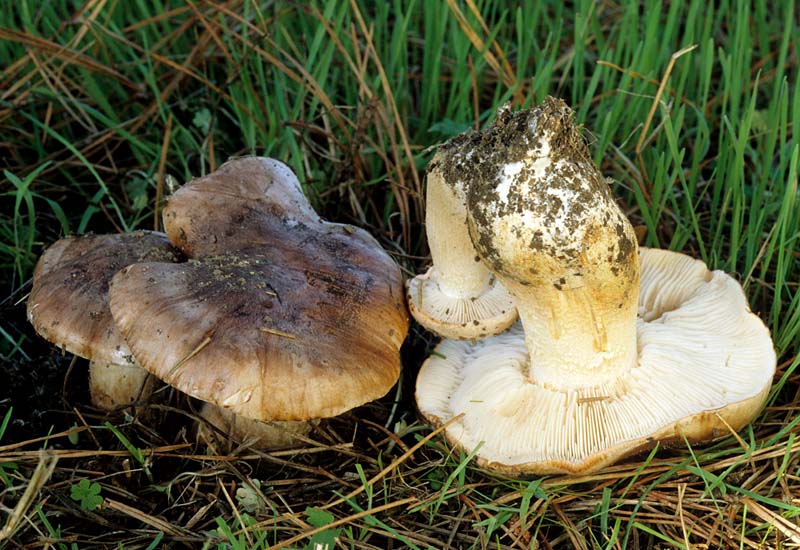Tricholoma (odors)
Scroll Down to See the Discussion


Sava: The mention of farinaceous odor in a previous posting reminded me of Tricholoma,
many species of which have it.
But this genus has members with other distinctive odors,
and you will encounter them if you have not already.
Your task: Name five species of Tricholoma which have the following odors:
(1) strongly farinaceous
(2) cucumber, or watermelon rind
(3) soapy
(4) coal tar gas
(5) "cross between cinnamon candy and dirty socks"
Mike P. (1) Strongly farinaceous: T. subumbrinum and T. muricatum.
Sources: [1], which cites work by A. H. Smith, and [2]. All photos from [5]
T. muricatum (c) Michael Wood
(2) Cucumber or watermelon rind: T. vernaticum. Sources:
[1], which cites Shanks's article describing the species (1996), and [3].
T. vernaticum (c) Michael Wood via MycoWeb
(3) Soapy: T. saponaceum, not surprisingly. Sources: [1] and [4]
T. saponaceum (c) Michael Wood
(4) Coal tar gas: T. sulphurescens is described as having a variety of odors, including this one.
Sources: [1], which cites Bessette for this characteristic,
and [2], which also lists T. inamoenum. A later Web search turned up T. odorum on [6].
(5) Candy and socks: T. magnivelare and T. caligatum, the matsutakes.
(Has anyone here found the latter?) Sources: [3] and [2]
.
Sources
[1] MatchMaker software
[2] McKenny & Stuntz, New Savory Wild Mushroom
[3] Arora, Mushrooms Demystified
[4] O. K. Miller, Mushrooms of North America
[5] Wood & Stevens, The Fungi of California (web site), http://www.mykoweb.com/CAF/index.html
[6] Kuo, M. (2006, October). Tricholoma odorum.
Retrieved from the MushroomExpert.Com Web site: http://www.mushroomexpert.com/tricholoma_odorum.html
Dick B. Regarding your question about T. caligatum;
we have a mushroom that has been called T. caligatum
but apparently is not the same as the European and East Coast T. caligatum.
It is not found as frequently as T. magnivelare.-Dick
Sava: I believe that the most commonly seen strongly farinaceous Trich
in this area is T. focale, arguably prettier (but, alas, not good to eat)
than Matsutake and found in similar places and at the same time (October).
Worth making a note of it now.
T. vernaticum (described as Armillaria olida in Arora's MD) and T. saponaceum are
frequently found in May-June in our mountains,
so we may see and smell them soon.
I must say that I never felt the soapy odor in the latter.
I'm adding a photo of T. caligatum taken in Oct. 2010, the only time I've found it.
Note the veil and the difference in stipe color above and below the veil,
more pronounced than in Dick's collection.
Actually, it looks to me that Dick's Trich might be something else.
The habitat does not seem right: T. caligatum typically grows in woods (as does Matsutake).



